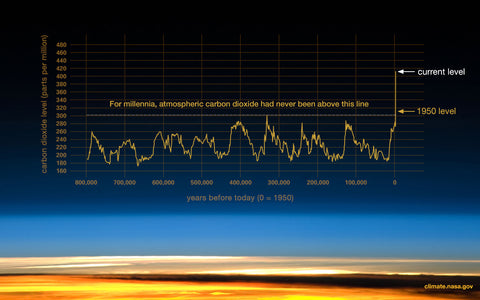While many of us have been aware of climate change or global warming for a long time, we know it may have been awhile since we were last well-acquainted with the ins and outs of what exactly is happening and why it’s a problem. Or there are probably a lot of us who never really got the full lowdown and have been kind of quietly wondering what the big deal is.
For me personally, I grew up knowing it was important to care about the environment, and my Christian upbringing taught me to be a good steward of the earth. I watched a little Captain Planet and saw all the PSAs about not littering, pollution being bad for us, and recycling being really good. Then my dad took me to see An Inconvenient Truth, which upped the ante quite a bit. Caring about the planet went from being a nice facet of being a generally conscious human being to an existential crisis of sorts. How could I make a difference in slowing the climate crisis and mitigating the effects on our planet and communities?
I learned more about the science and consequences of climate change in some college classes that not everyone takes and then in reports and updates from the Intergovernmental Panel on Climate Change, Project Drawdown, and a variety of other publications that not everyone reads. We may not all know about the details of what is now a very urgent climate emergency, but we will all be affected by it, so we thought this was an appropriate time to give everyone a refresher.
Here are some answers to key questions about what climate change is, how it’s happening, and why it’s a big deal:
What is climate change?
Let’s get one thing straight right off the bat: weather is different than climate. According to Oxford Languages, weather is “the state of the atmosphere at a place and time as regards heat, dryness, sunshine, wind, rain, etc,” while climate reflects “the weather conditions prevailing in an area in general or over a long period.” The weather in Portland today is sunny with a high of 72 degrees Fahrenheit, a low of 53 degrees, and 57% humidity. Portland has a temperate oceanic type of climate where our summers are warm and dry and winters are rainy and cool. The average annual high is 63 degrees Fahrenheit while the low is 46 degrees.
“Climate change is a significant variation of average weather conditions—say, conditions becoming warmer, wetter, or drier—over several decades or more. It’s that longer-term trend that differentiates climate change from natural weather variability. And while 'climate change' and 'global warming' are often used interchangeably, global warming—the recent rise in the global average temperature near the earth’s surface—is just one aspect of climate change.” -National Resource Defense Council
How normal is it?
It’s natural for the Earth’s climate to change from time to time, and our planet has undergone many significant warming and cooling periods throughout its history, most of which were long before human existence and civilization. There are a variety of factors that have contributed to this in the past, including volcanic eruptions, shifts in the Earth’s orbit that affect how much solar energy we get, and naturally occurring greenhouse gases. “Just in the last 650,000 years there have been seven cycles of glacial advance and retreat, with the abrupt end of the last ice age about 11,700 years ago marking the beginning of the modern climate era — and of human civilization.” -NASA
The not-so-normal part about what’s happening now is that the increase in carbon dioxide in our atmosphere and the rate at which it has been increasing far surpasses the range of normal levels that could be attributed to those natural causes.
How has the climate been getting warmer?
To understand how the planet is warming, let’s break down the greenhouse effect.
The Earth’s atmosphere acts as its own kind of greenhouse. Imagine a greenhouse filled with plants and made of glass walls. When the sun shines through the glass, the warmth gets trapped inside its walls, which helps maintain a comfortable environment in which the plants can thrive in a more temperate environment than if they were exposed to the elements outside of the greenhouse.
The Earth’s atmosphere does the same thing, making our planet livable for the many species and ecosystems that call it home. “Solar energy radiating back to space from the Earth's surface is absorbed by greenhouse gases and re-emitted in all directions. This heats both the lower atmosphere and the surface of the planet. Without this effect, the Earth would be about 30C colder and hostile to life,” says the BBC.
Ok imagine now that you step into your car that’s been sitting in the sun on a cool, fall day. It might be nice and cozy in there from the sun’s heat, but if you’ve ever sat in a car for a while doing a lot of talking (or other activity) -- emitting carbon dioxide from your own mouth, you might notice the windows starting to get foggy and the environment of the car getting uncomfortably warm.
“Scientists believe we are adding to the natural greenhouse effect, with gases released from industry and agriculture trapping more energy and increasing the temperature,” according to the BBC. It’s getting uncomfortably warm up in here, y’all, and we don’t have a window to crack.
How are humans making it worse?
We’re producing A LOT of greenhouse gas emissions. Since the Industrial Revolution, beginning around 1750, CO2 levels have risen close to 40%, resulting primarily from the burning of fossil fuels like coal, oil, and gas for electricity, heat, and transportation. (Source: NRDC)
“A second major source is deforestation, which releases sequestered carbon into the air. It’s estimated that logging, clear-cutting, fires, and other forms of forest degradation contribute up to 20 percent of global carbon emissions. Other human activities that generate air pollution include fertilizer use (a primary source of nitrous oxide emissions), livestock production (cattle, buffalo, sheep, and goats are major methane emitters), and certain industrial processes that release fluorinated gases. Activities like agriculture and road construction can change the reflectivity of the earth’s surface, leading to local warming or cooling, too.” -National Resource Defense Council
Human activities have caused the earth’s average temperature to rise about 1 degree Fahrenheit in just the last century. “If that doesn’t sound like much, consider this: When the last ice age ended and the northeastern United States was covered by more than 3,000 feet of ice, average temperatures were just 5 to 9 degrees cooler than they are now.” -National Resource Defense Council
Why is it a big deal?
Long story short: When the climate changes significantly, it typically has dramatic effects on the many fragile ecosystems that make up our planet, and our survival as a species depends upon the balance of those ecosystems.
We’re currently on pace to reach 1,000 ppm of CO2 by the end of the century. The last time we had that much carbon dioxide in our atmosphere was the late-Paleocene and early-Eocene epochs, from around 56 to 48 million years ago, when a global warming event known as the Paleocene-Eocene Thermal Maximum or PETM resulted sea levels rising, oceans becoming more acidic, and widespread extinctions. As a result, our planet looked very different.
“The most striking feature of this early age of mammals is that it was almost unbelievably hot, so hot that around 50 million years ago there were crocodiles, palm trees, and sand tiger sharks in the Arctic Circle. On the other side of the blue-green orb, in waters that today would surround Antarctica, sea-surface temperatures might have topped an unthinkable 86 degrees Fahrenheit, with near-tropical forests on Antarctica itself. There were perhaps even sprawling, febrile dead zones spanning the tropics, too hot even for animal or plant life of any sort.” -The Atlantic
The good news: our planet has survived dramatic changes in the past. It adapts and finds new ways to balance itself in time.
The bad news: those same dramatic changes can result in major casualties, including entire species. Best case scenario: we lose some very cute and important animals and plants. Worse case scenario: humanity itself is on the chopping block.
The next natural questions: what will the effects be, how soon will they happen, and is there anything we can do about it? Spoiler alert: the answer to the last question is yes! (Had to end on a positive note!)
Stay tuned for the answers to those questions and more in Parts 2 and 3 of our Climate Change Refresher series, coming soon!
-Alex Gamboa Grand




